By Patrick O’Neill, Founder and President, Redhand Advisors
Technology has changed the way your business operates. But without a RMIS that can adapt, you may not be able to manage your risk effectively.
Many organizations are still operating on legacy technology. A legacy system can’t perform the types of functions needed in today’s fast-paced environment — nor work across your entire enterprise very well. Many of these legacy systems cannot be upgraded to gain new, necessary capabilities, making them unable to support emerging enterprise risk and environmental, social, and governance-related risk, for example.
Today’s systems, however, are built with new technology, making them more configurable and scalable. Deployed as Software as a Service (SaaS), these systems can be upgraded routinely to provide the most up-to-date capabilities and functionality.
Here are four reasons why you should upgrade your risk technology platform in 2022:
- Enterprise deployment of your RMIS platform
According to the research we did for our 2022 RMIS Report, the number of users each
organization is now putting on their risk management tech solutions has grown exponentially in the last five years. Cloud deployments make it easier to onboard users beyond your core team — from an average of five users to now more than 10, with many businesses having dozens or even hundreds of RMIS users.
Organizations are expanding the system to key personnel throughout the organization to give them real-time access to the risk data necessary to do their jobs. They also use the system to report key risk data directly through the system, improving the communication process.
In addition, there has been a shift in what a RMIS is utilized for. While claims management, exposures, and insurance policy management were always key components, environmental health and safety, benchmarking, and enterprise risk management are more common RMIS tools than in the past.
2. Easier integration with other systems
Previously, integration with other systems wasn’t easy with legacy RMIS systems. New systems built with open application programming interfaces (API) allow systems to talk to each other and make integration easier. It’s now a configuration; integration can be seamless if both systems are more modern.
The new technology also eases internal integration and integration with third-party tools. In the past, you’d have to send out reports on a periodic basis to other stakeholders. Now, for example, your RMIS can be linked to your finance system to transmit data automatically.
With third-party tools, new RiskTech solutions and add-ons come into play. Many of these solutions enhance the capabilities of your core system and provide niche functionality that may not exist in your core system.
3. Improved productivity
Where older systems are inefficient, new RMIS systems and RiskTech solutions are built to help streamline workflows and improve productivity. For example, if a policy or Certificate of Insurance (COI) is expiring, a notification can be directly routed to the right person to ensure the newest COI is obtained. By freeing time from tasks that can be automated, teams can take critical steps to solve problems with reporting and analytics.
This improved productivity can also aid collaboration. With old systems, team members would work with the risk data and then take it outside the system to share with other members of the team. Much of that collaboration and work can now be done within the RMIS itself, with an automated system that sends requests, providing a more collaborative experience.
4. Mobile-ready data accessibility
The new systems allow you to access your data from anywhere on any device. Users can pull up any information they need on a mobile browser, even without an app. Dashboards manage the entire risk across your portfolio, automatically pulling reports that historically were individually run and compiled.
Under One Umbrella
Yesterday’s systems don’t meet the requirements of today’s risk environment. But today’s RMIS systems allow you to bring everything you need to do together to manage risk under one umbrella.
Schedule an inquiry call for more information on how today’s RMIS systems allow you to bring everything you need for proper risk management under one umbrella.
